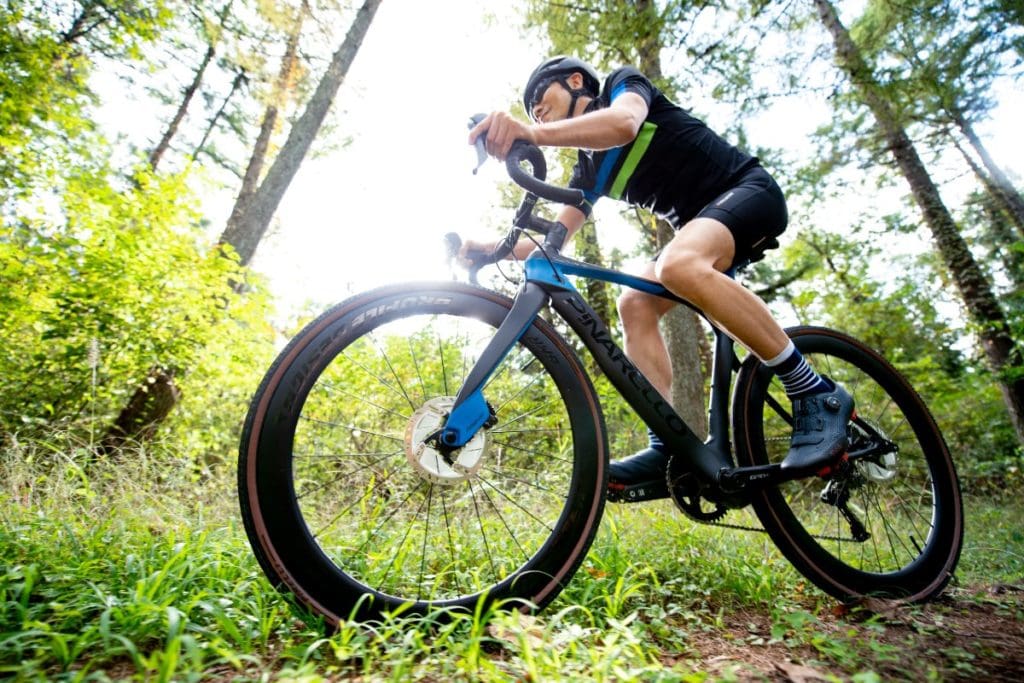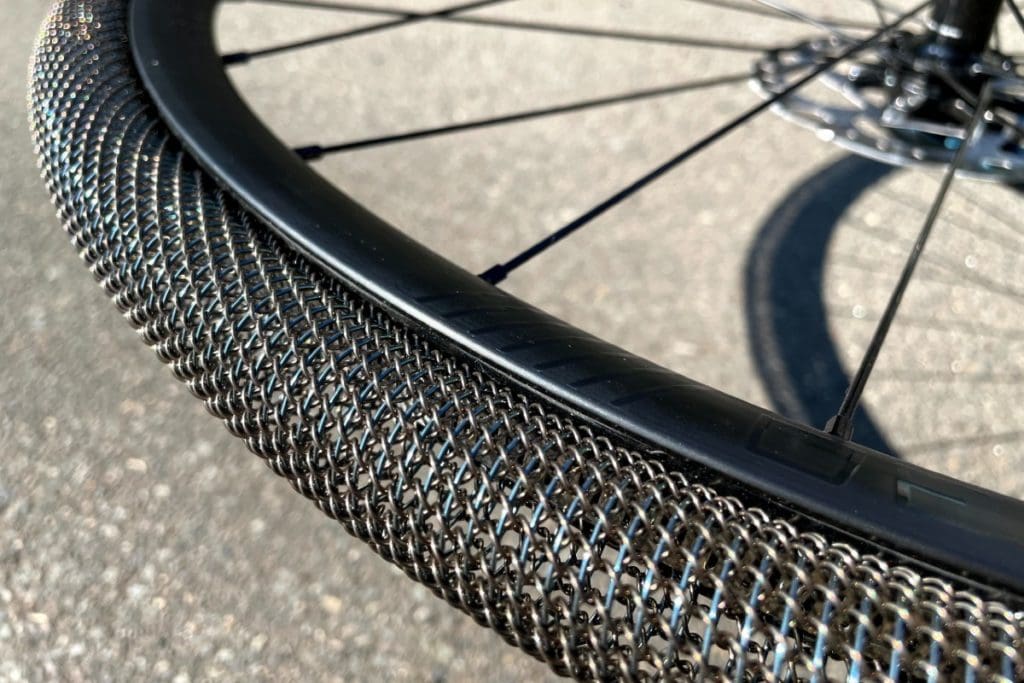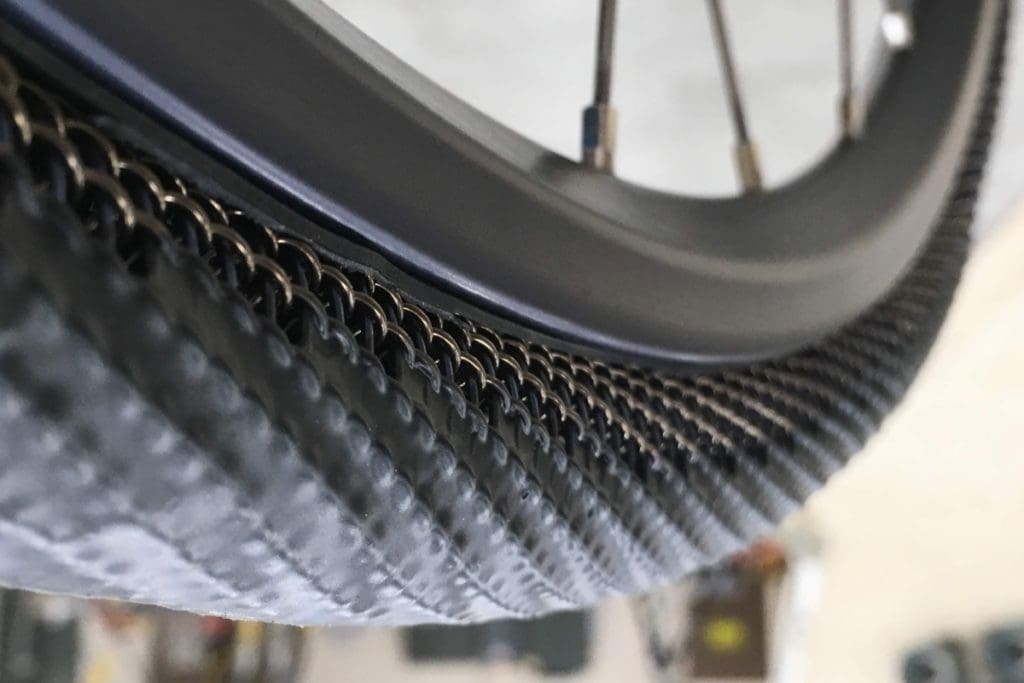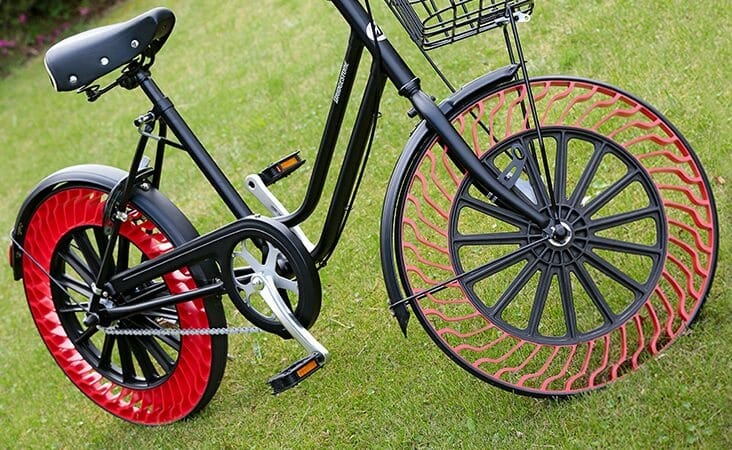Wheel Innovation Building Momentum

California, USA
Bicycle wheels and tyres have experienced an unprecedented rate of change in the past few years but could all that recent headway become obsolete just as quickly?
Tyre widths, rim construction and the shift to tubeless technology have been at the heart of recent bike innovation. However, seemingly imminent breakthroughs are promising to replace pneumatic tyres completely.
Mainstream thinking on the optimum width for wheels and tyres has shifted dramatically. Only a couple of years ago, debate focused on the benefits or otherwise of shifting from 23mm to 25mm road tyres. No sooner had that discussion subsided, and those ‘wider’ tyres have suddenly been gazumped by 28mm and even broader alternatives.
That transformation has been accompanied by a broadscale shift to tubeless and hookless tyres.
They are all moves made by the mountain biking community long ago and the path for the road fraternity might have been cleared somewhat by the emergence of their more closely-related gravel biking cousins. However, these shifts have predictably brought much greater resistance and debate among the more traditionalist road cycling clan.
Innovators have always been looking at ways to improve the humble bicycle wheel. But in general, there have only been incremental changes since the first pneumatic tyre design was patented in 1846.
Current wheel and tyre designs – along with many other features of the no-longer-quite-so-humble bicycle – are now being whisked along at an accelerating rate of transformation.
Sure, there have been quite radical changes at the relative fringes of cycling. For example, the emergence of triathlon in the 1980s and ‘90s helped trigger a surge of wheel innovations, such as wide carbon spokes to unconventional spoke patterns.
However, these ‘breakthroughs’ largely came and went and never achieved broad adoption beyond athletes looking to shave a few seconds off their race times.
In contrast, current changes such as wider rims and tyres look set to send their out-of-favour alternatives towards a path to extinction.
The debate on wider tyres does spark some speculation about whether this trend will just become a cyclic fashion, infinitely expanding and contracting like Einstein’s theory of a ‘bouncing’ universe. But tests seeking to quantify the benefits of wider tyres are starting to show advantages in rolling resistance, traction and reduced fatigue from vibration – albeit among other studies that have found negligible benefit in real world conditions.
Broader rims and advances in materials have also enabled road riders to join their off-road counterparts and embrace tubeless tyres. Lower tyres pressure made possible – and preferable – by wider rims have allowed tyre manufacturers to move away from hooked tyres.
This has sparked some conjecture about whether this is largely driven by cost savings in manufacturing both rims and tyres. However, companies such as Zipp say they facilitate a more aerodynamic interface between rim and tyre and allow the rims to be manufactured in a way that makes them much lighter and stronger.
Air Today, Gone Tomorrow
All of this innovation could soon be rendered obsolete, with US company SMART Tires preparing to start commercial production and sales of its completely airless Metl bike tyres as soon as next year.
According to statements from SMART Tires, the Metl uses the same Shape Memory Alloy Radial Technology (SMART) materials that are set to be deployed on NASA’s Fetch Rover mission to Mars in 2026.
“In order to address the extreme requirements of Mars missions, those tires use an airless structure made from a special nickel-titanium alloy called NiTinol. Through a unique characteristic of this material, the tires are able to rearrange their molecular structure in response to mechanical strain, an almost magical property called ‘superelasticity’,” according to SMART Tires co-founder and CEO Earl Cole.
“We’re seeing tyres that can deform as much as we design them to, in some cases all the way to the wheel rim, and have 100% instant recovery.”
SMART Tires says the Metl bike tyres will be coated with a new, poly-rubber material to provide long-lasting tread and grip for all weather conditions
The company is claiming Metls could last the life of the bicycle, with “no leaks, tears, punctures or messy sealants”.
Mr Coles claims Metls would not only bring the environmental benefits of not having to dispose of mountains of damaged or worn-out tyres. They would also eliminate the huge amount of rubber dust created by tyre wear, which currently accounts for 20 to 30% of all plastic that makes its way into the oceans.
The Latz Report sought to get an update from SMART Tires to see if the company is still on track for a 2022 commercial release but it could not be contacted.
Not surprisingly, SMART Tires is not the only company working to develop airless tyres.
Bridgestone Tyres has spent the past few years honing ‘Air Free Concept’ technology, which uses a unique structure of resin spokes stretching along the inner sides of tyres.
It had been suggested the wheels would be used on bicycles in the Olympic Village for the 2020 Tokyo Games but it seems that didn’t materialise, even though the technology was used on the village’s electric vehicles.
Join the Conversation:
Are airless tyres the future for modern bicycles?
Wheels & Tyres: Distributors in Australia
The Latz Report YearBook lists any organisation that supplies goods or services to bicycle retailers or interacts with them in some bike industry related way.
For details of bicycle wheel, wheel parts and bicycle tyre distributors in Australia, please follow this link to our Yearbook and use the Search function or Direct to Page option, to find:
- Hubs on page page 106
- Rim Tapes on page 108
- Rims on page 109
- Spokes on page 110
- Tyre Sealants on page 112
- Tyres and Tubes on page 112
- Wheel Skewers on page 112
- Wheels on page 112
- Wheels – Custom Built to Order on page 112.
Use the Address list starting from page 20 to find the direct contact details for each of the distributors listed on the above pages.
Make sure your listing is correct in the YearBook.
- Update your details for our 2022 edition.
- Add a new listing in our 2022 edition.


Next Month…
Our Annual Guide for January will be focused on Bottles, Hydration and Nutrition. Please contact Ed Price as soon as possible if you would like to highlight your Product or feature your Company in this edition.
For future editions of the Annual Guides, please see our planned Media Schedule for 2022.




hmm airless tyres huh
takes me back to a time when clinchers ‘were coming in’ ie been made comparably fast to tubulars ..it all comes down to the tyres construction and weight I think the industry is hypocritical .. it sells ‘new’ saying how much better/faster ‘new’ is.. like every last second counts (well it does in track timed events esp) but really..its cost effectiveness that ppl are buying. clinchers with tubes are easier to repair, cheaper there has been some hell fast clinchers in the past (like the old specialized Turbo vr’) but they were skinny and I dont think as grippy as say a good Vitt corsa cx was back then its the same ol sht at the end of the day some ol reasons, same ol arguments same ol pro’s and cons but the never changing universal truth is that it’s really the monkey on the bike that matters most.
Hi Greg,
Thanks for your feedback. There will always be innovations seeking to improve on the technology and there’s no doubt wheels and tyres have come along way, even if the fundamentals and the essence of what constitute a good wheel and tyre remain largely the same.
Even within the constant attraction of cost effectiveness, what changes have you seen with the expectations or demands of customers?
Re. the airless tyres, the Smart Tire Company’s promise of a tyre that will last the lifetime of the bike was a particularly bold and interesting claim. Is this a reflection on expectations of a shorter lifespan for bikes, as well as the durability of Metl tyres?